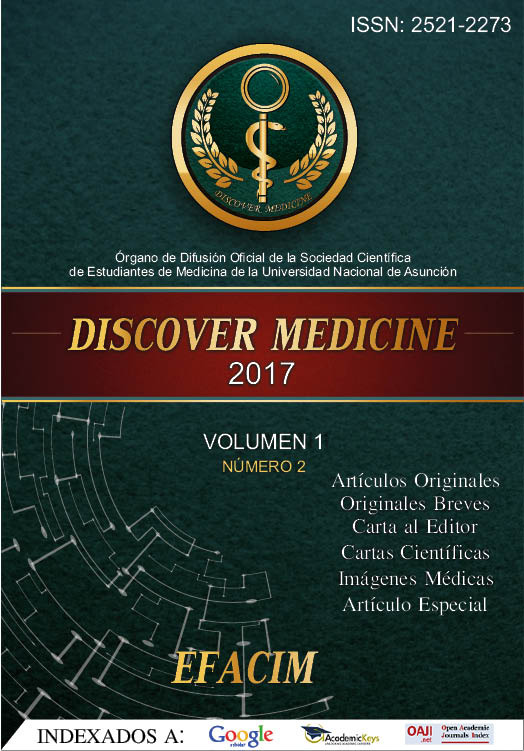Abstract
Background: Staphylococcus aureus is the main microorganism that causes nosocomial infections because it inhabits both the mucous membranes and the skin. The present work was carried out to determine the frequency of nasal carriage of Staphylococcus aureus in the staff of the Adult Intensive Care Unit (UCIA) and Intermediate (UCI) and to relate the possible risk factors in the health population that facilitate the carriage mentioned.
Methods: Descriptive observational, cross-sectional, prospective study in health personnel of a university hospital in the UCIA and UCI.
Results: A total of 50 people from the UCIA and UCI areas of the “Hospital de Clínicas de la Facultad de Ciencias Médicas de la Universidad Nacional de Asunción”. Corresponds to UCIA 46% and UCI 54% of the sample. A positive nasal swab culture was found in 28% of the individuals. The associated risk factors were: chronic diseases, skin lesions, poor handwashing.
Conclusion: The nursing staff presented a higher number of colonization by S. aureus. Taking into consideration the percentage of carriers of this bacterium that are in these hospital
References
PR Murray, KS Rosenthal, MA Pfaller. Microbiología Médica. 7.a ed. Barcelona: Elsevier; 2013.
Jawetz E, Melnick J, Adelberg E, Morse S, Brooks G, Toni M. Microbiología Médica. 25.a ed. México DF: Piccin; 2011.
Kumate J, Gutiérrez G. Infectología Clínica. 17a ed. México, DF: Méndez Editores; 2013.
Arquimedes Canese, Andres Canese. Manual de microbiología y parasitología médica. 7a ed. Asunción:Efacim; 194-204 p.
Pathogen Safety Data Sheets: Infectious Substances – Staphylococcus aureus [Internet]. 2012 [citado 13 Oct 2017]. Disponible en: https://www.canada.ca/en/public-health/services/laboratorybiosafety-biosecurity/pathogen-safety-data-sheets-riskassessment/staphylococcus-aureus.html
Instituto Nacional de Seguridad, Salud y Bienestar en el Trabajo. Inicio | Instituto Nacional de Seguridad e Higiene en el Trabajo (INSHT) [Internet]. [citado 13 Oct 2017]. Disponible en: http://www.insht.es/portal/site/Insht/
Karabay O, Otkun MT, Yavuz MT, Otkun M. Nasal carriage of methicillin-resistant and methicillinsusceptible Staphylococcus aureus in nursing home residents in Bolu,Turkey. West Indian Med J. 2006;55(3):183-7.
Patel JB, Weinstein MP, Eliopoulos GM, Jenkins SG, Lewis JS, Limbago B, et al. Performance Standars for Antimicrobial Susceptibility Testing. 27a ed. Wayne, PA: Clinic and Laboratory Standards Institute; 2017.
GIL D de M. M. Staphylococcus aureus: Microbiología y aspectos moleculares de la resistencia a meticilina. Rev Chil Infectol. 2000;17(2):145-52.
von Eiff C, Becker K, Machka K, Stammer H, Peters G. Nasal Carriage as a Source of Staphylococcus aureus Bacteremia. N Engl J Med. 4 de enero de 2001;344(1):11-6.
Kluytmans J, van Belkum A, Verbrugh H. Nasal carriage of Staphylococcus aureus: epidemiology, underlying mechanisms, and associated risks. Clin Microbiol Rev. 1997;10(3):505-20.
VandenBergh MF, Yzerman EP, van Belkum A, Boelens HA, Sijmons M, Verbrugh HA. Follow-up of Staphylococcus aureus nasal carriage after 8 years: redefining the persistent carrier state. J Clin Microbiol. octubre de 1999;37(10):3133-40.
Lowy FD. Staphylococcus aureus Infections. N Engl J Med. 20 de agosto de 1998;339(8):520-32.
Emori TG, Gaynes RP. An overview of nosocomial infections, including the role of the microbiology laboratory. Clin Microbiol Rev. octubre de 1993;6(4):428-42.
Kollef MH, Fraser VJ. Antibiotic Resistance in the Intensive Care Unit. Ann Intern Med. 2001;134(4):298.
Callisaya HJ, Sarmiento Z, Choque CH. Prevalencia de Portadores Nasales de Staphylococcus aureus en el personal de limpieza del Hospital Obrero. BIOFARBO. /;55.
Montalvo R, Huaroto L, Alvarezcano J, Ticona E, García Y. Prevalencia de portadores nasales por Staphylococcus aureus meticilino resistente en personal de salud del servicio de Cuidados intensivos, Hospital Nacional Dos de Mayo. 2009;13(2):1-5.
Dávalos K, Báez S, Bianco H, Figueredo B, Ayala C, Ortellado J, et al. Portación Nasal de Staphylococcus aureus en Personal Hospitalario en Unidades de Cuidados Intensivos Adultos. An Fac Cienc Méd. 2008;XLI(1 y 2):56-62.

This work is licensed under a Creative Commons Attribution-NonCommercial-NoDerivatives 4.0 International License.
Copyright (c) 2023 Abel Osmar Pereira Gómez, Adriana Jazmin Quiñonez Britez, Tania Magali Ojeda Ozuna, Adriana Denise Neumann Ramírez, Camila Ramírez Ríos, Debora Penner Sawatzky, Lourdes Judith Paredes Medina, Paola Mercedes Ramírez Maciel, Ricardo Jesús Olmedo Cabral, Ana María Ovando Ricardo, Rosalía Elizabeth Obelar Martínez, Rubén Dario Pavón Diarte, Sergio Ivan Nuñez Samudio, Fátima Sol Ramírez Pereira, Ana Claudia Pino Abdo, Isabela Ortega Cano Arias, Sebastián Joaquín Ocampo Rojas, Benjamin Mathias Rafael Quiñónez Torres, Gladys Raquel Velazquez Aguayo
